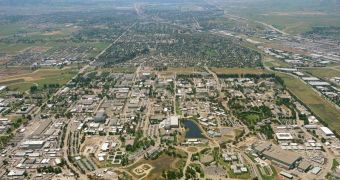The US National Nuclear Security Administration (NNSA) announced yesterday that scientists at the Department of Energy's (DOE) Lawrence Livermore National Laboratory (LLNL), and the National Ignition Facility (NIF) managed to obtain the most powerful burst of laser in the world. The shot, which was delivered to a target in just a few billionths of a second, was about 30 times more powerful than any others obtained around the world, and was measured to have an energy level of 1 megajoule. Ulterior analysis of the target on which the laser pulse was fired demonstrated that it had achieved all of the conditions necessary for obtaining nuclear fusion, PhysOrg reports.
“Breaking the megajoule barrier brings us one step closer to fusion ignition at the National Ignition Facility, and shows the universe of opportunities made possible by one of the largest scientific and engineering challenges of our time. NIF is a critical component in our stockpile stewardship program to maintain a safe, secure and effective nuclear deterrent without underground nuclear testing. This milestone is an example of how our nation’s investment in nuclear security is producing benefits in other areas, from advances in energy technology to a better understanding of the Universe,” says Thomas D’Agostino, the administrator of the NNSA.
Experts reveal that the peak intensity of the laser light, during the femtoseconds it was active, was about 500 times that used by the entire continental US power grid at any given moment in time. The NIF goes about demonstrating nuclear fusion by using an ensemble of 192 powerful lasers, which are all focused in a very small cylinder, which contains a tiny capsule filled with the hydrogen compounds deuterium and tritium. The thing about the laser pulse is that, once inside the cylinder, it gets converted to X-rays, physicists say.
This means that the fuel inside the capsule is compressed together very tightly, at pressures billions of times greater than the atmospheric pressure our planet usually exerts. Temperatures of up to 200 million degrees Fahrenheit also develop, and the end result should be the deuterium and tritium nuclei fusing together. This would release impressive amounts of energy, a lot more than what went in to produce the laser beam that triggered the reaction, experts say. That is the basic concept of nuclear fusion. As these nuclei combine, all that results is helium, and energy, and therefore fusion will arguably be the cleanest form of energy.
“This accomplishment is a major milestone that demonstrates both the power and the reliability of NIF’s integrated laser system, the precision targets and the integration of the scientific diagnostics needed to begin ignition experiments. NIF has shown that it can consistently deliver the energy required to conduct ignition experiments later this year,” says Ed Moses, the director of the NIF. Because of the unique qualification of its engineers, and the one-of-a-kind scientific instruments it has at its disposal, the National Ignition Facility is expected to be the first organization to achieve nuclear fusion.

 14 DAY TRIAL //
14 DAY TRIAL //